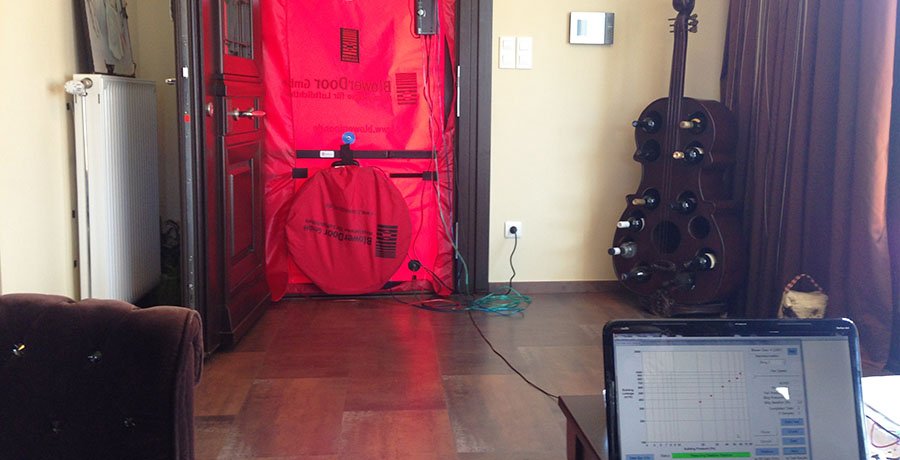Blower Door Test
Andreoy Insulation SA, following the thermography inspection that has introduced for years on quality control of energy blueprints in buildings, offers another ''weapon'' in combating energy losses and energy savings in buildings.
Through the blower door test combined with the thermogravimetric inspection with our modern thermal cameras, we can detect points of inflow and / or air leakage which are invisible to the naked eye (but also in the thrermal cameras without the help of the blower door).
The company Andreoy Insulation SA has:
- Four level 1 certified thermographers.
- Two level 2 certified thermographers.
- Civil engineers.
- Mechanical engineer.
- Energy appraiser
- Mordern thermal cameras
- Bloower door, for airtightness inspection
Energy inspections according to international standards
Andreoy Insulation SA performs energy inspections according to:
- Inspection with Infrared thermal camera according to EN 13187: 1998, for the determination of thermal performance and qualitative detection of thermal irregularities in the building envelope
- Airtightness inspection according to ISO 9972: 2015
- Air pressure inspection that penetrates joints of the openings according to the European standard DIN EN 12207.
In combination with the specialization of the above staff in the field of construction, the proper equipment and our experience of the dozens air tightness inspections that we have successfully performe in homes and industrial / commercial buildings, we can provide solutions.
- Trust Andreoy Insulation SA as well as thousands of others. It applies:
- Quality Control System ISO 9001: 2015 & Environmental Management System ISO 14001: 2015
- Occupational Health and Safety Management System ISO 45001:2018
- All the construction crews of Andreoy Insulation SA consist of:
- Civil Engineers
- Certified technicians on Insulations / Insulators by ESYD in accordance with the International Standard ISO / IEC 170244
- Specialized and certified technicians according to DIN CERTCO
- Andreoy Insulation SA is a member of:
- Pan-Hellenic Association of Insulation Companies (PESM)
- European Federation of Associations of Insulation Contractors (FESI)
- Panhellenic Association of Inflated Polystyrene - EPS HELLAS
- Association of Greek Manufacturers of Aluminum and Related Products (SEKA)
- Hellenic Institute of Fire Protection of Constructions (ΕLIPYKA)
Ask for our offer and prices for blower door test
Contact us. We give solutions. Simply!
- Fill the contact form
- Call us at the following telephone numbers: 210 62 55 780, 22 210 79 950
- Come to our technical departments in Athens and Chalkida
- Visit our Facebook and Twitter pages and send a message
Do you have a house, a block of flats, a commercial building or industrial building? Contact us and tell us your problem that you have.
A thermographer will explain you the solutions which the airtightness inspection will offer you
Some examples of airtightness inspections
See some of the blower door test that we have perform
Why is the air tightness inspection useful?
The proper confrontation of problematic points of inflow or air leakage into the building, we can achieve up to 20% energy savings through the reduction of air-flow in the building.
The achievement of buildings with nearly zero energy consumption for heating-cooling-Hot Water System (Passive Buildings), it is not practically reliable or feasible without the are introduction of the software and the method of measuring the airtightness of buildings.
This is also the common practice in the advanced countries of the Eurozone, where a Blower door test is required for the high-performance energy certificate, which is performed on a specific standards.
Especially for large industrial and commercial units, refrigeration and freezing chambers, the blower door test is necessary for the building to be delivered for operation
For example, a building with theoretically zero losses due to treatment and radiation (U = 0.00W / m2K) and a moderate degree of air tightness (n50 = 3.00 according to international standards) would have in a moderate Greek climate requirements for heating- at 15KWh / m2.
These losses should have the opportunity to be assessed in more detail, at least for buildings where the goal is the high energy saving. This criterion has already been introduced in Eurozone countries.





